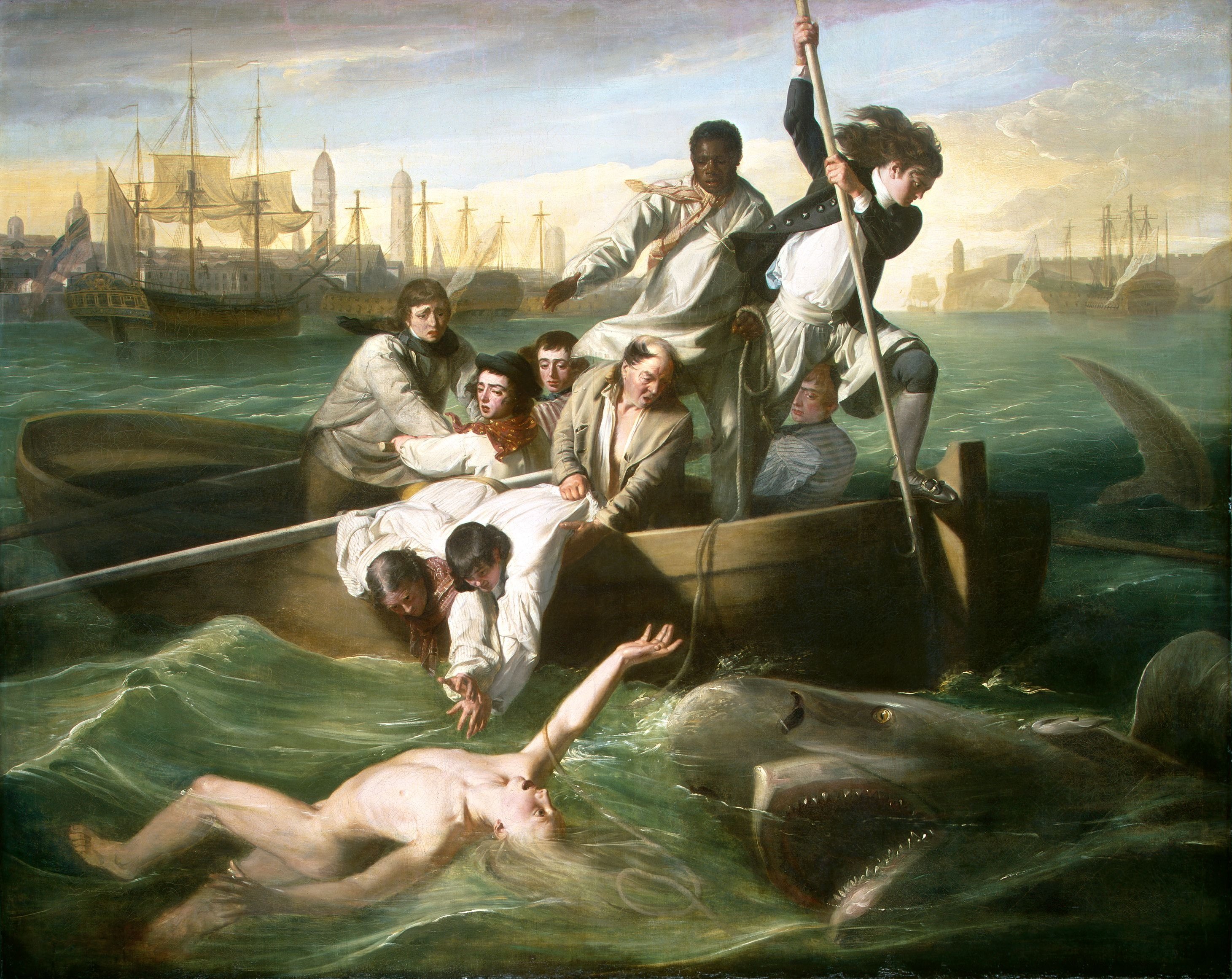- Watson and the Shark
title=Watson and the Shark
artist=John Singleton Copley
year=1778
type=Oil-on-canvas
height=182.1
width=229.7
height_inch=71¾
width_inch =90½
museum =National Gallery of Art
city =Washington, D.C. "Watson and the Shark" is the title of a 1778 oil-on-canvas painting by
John Singleton Copley . It depicts the rescue ofBrook Watson from ashark attack inHavana ,Cuba .Background
The painting is based on a real attack that took place in Havana Harbor in 1749. Brook Watson was a 14-year-old orphan, serving as a crew member on a trading ship. While swimming alone in the harbour, he suffered multiple attacks by a single shark. On its first attack, the shark bit off a chunk of flesh from Watson's right leg below the calf; on the second attack, it removed his foot at the ankle. The crew of a small boat, who had been waiting to escort their captain to shore, fought off the shark and rescued Watson. His leg was amputated below the knee, but he went on to live a full life, including a term as Lord Mayor of London. The attack is the earliest shark attack to be fully documented.
Painting
Copley had become friends with Brook Watson after he arrived in
London in 1774, and produced three versions of the painting depicting the 1749 shark attack. It is likely that Watson commissioned the original from Copley; on his death he bequeathed it toChrist's Hospital , which retained a copy of the picture after selling the original, with the hope that it would prove "a most useful Lesson to Youth" . It was the first in the series of the large scale historical paintings that Copley would concentrate on after settling in London. The painting is romanticised: the gory detail of the injury is hidden beneath the waves (although there is a hint of blood in the water), and the figure of Watson is based on the statue of the "Borghese Gladiator ", byAgasias of Ephesus , which is held in the collection of theLouvre , inParis . Further apparent influences areRenaissance art , and the ancient statue ofLaocoön and his Sons that Copley may have seen inRome . Undoubtedly, Copley was influenced byBenjamin West 's "The Death of General Wolfe ", and the growing popularity of romantic painting. The composition of the rescuers in the boat shows hints of Rubens' "Jonah Thrown into the Sea ", and both Rubens' "Miraculous Draught of Fishes " andRaphael 's painting of the same name. The facial expressions show a marked resemblance to those inCharles Le Brun 's "Conférence de M. Le Brun sur l'expression générale et particulière", an influential work published in 1698; they portray a range of emotions, from fear to courage. Various elements of composition were changed as the painting progressed. Infrared analysis shows the old bosun was originally a young man, and the preliminary sketches reveal that the black sailor at the rear of the boat, who also appears as the subject of Copley's "Head of a Negro" painted around the same time, was originally envisioned as a white sailor, with long flowing hair.The painting was exhibited at the
Royal Academy in 1778. Copley produced a second, full-size replica for himself, which is in the Museum of Fine Arts, Boston, and a third smaller version, with a more upright composition, which is now held in theDetroit Institute of Arts . The original is in theNational Gallery of Art ,Washington, D.C. Copley had never visited Havana, and it is likely that he had never seen a shark, much less a shark attack. It is probable that he gleaned details of Havana Harbour from other paintings and illustrations: he includes the real landmark of Morro Castle in the background of the painting. The shark is less convincing; it includes artistic details not found in sharks, such as forward-facing eyes, and lips that appear to be based on the preserved jawbones of an actual shark. While not identifiable as any specific species, it is still clearly recognizable as a shark.
References
*cite web|url=http://www.nga.gov/feature/watson/|title=Watson and the Shark|publisher=National Gallery of Art, Washington DC|date=2006|accessdate=12 November|accessyear=2006
*cite web|url=http://www.nga.gov/collection/gallery/gg60b/gg60b-46188.0.html|title=The Collection: Watson and the Shark|publisher=National Gallery of Art, Washington DC|date=2006|accessdate=12 November|accessyear=2006
*cite web|url=http://www.smithsonianeducation.org/spotlight/artists1.html|title=Spotlight Biography: Artists: John Singleton Copley|publisher=Smithsonian Education|date=2006|accessdate=12 November|accessyear=2006
*cite web|url=http://www.nmm.ac.uk/mag/pages/mnuInDepth/Biography.cfm?biog=164|title=Biography of John Singleton Copley (1738–1815)|publisher=National Maritime Museum, Greenwich|accessdate=12 November|accessyear=2006
*cite journal|author=Bendersky, Gordon|title=The Original "Jaws" Attack|journal=Perspectives in Biology and Medicine|volume=45|issue=3|date=2002|pages=426–432|publisher=The Johns Hopkins University Press|accessdate=12 November|accessyear=2006|doi=10.1353/pbm.2002.0043
Wikimedia Foundation. 2010.

